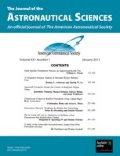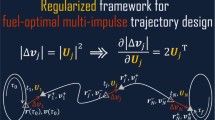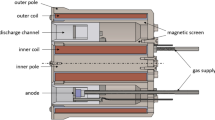Abstract
We develop a computational approach for the design of continuous low thrust transfers in the planar circular restricted three-body problem. The use of low thrust propulsion allows the spacecraft to depart from the natural dynamics and enables a wider range of transfers. We generate the reachable set of the spacecraft and use this to determine transfer opportunities, analogous to the intersection of control-free invariant manifolds. The reachable set is developed on a lower dimensional Poincaré section and used to design transfer trajectories. This is solved numerically as a discrete optimal control problem using a variational integrator, which preserves the geometric structure of the motion in the three-body problem. We demonstrate our approach with two numerical simulations of transfers in the Earth-Moon three-body system.













Similar content being viewed by others
References
Bryson, A.E., Ho, Y.C.: Applied Optimal Control: Optimization, Estimation and Control. CRC Press (1975)
Chang, D.E., Chichka, D.F., Marsden, J.E.: Lyapunov-based transfer between elliptic Keplerian orbits. Discret. Cont. Dyn. Syst. Series B 2(1), 57–68 (2002)
Choueiri, E.Y.: New dawn for electric rockets. Sci. Am. 300(2), 58–65 (2009). https://doi.org/10.1038/scientificamerican0209-58
Conley, C.C.: Low energy transit orbits in the restricted three-body problem. SIAM J. Appl. Math. 16(4), 732–746 (1968). http://www.jstor.org/stable/2099124
Dellnitz, M., Junge, O., Post, M., Thiere, B.: On target for venus – set oriented computation of energy efficient low thrust trajectories. Celest. Mech. Dyn. Astron. 95(1-4), 357–370 (2006). https://doi.org/10.1007/s10569-006-9008-y
Folta, D., Dichmann, D., Clark, P., Haapala, A., Howell, K.: Lunar cube transfer trajectory options. In: Proceedings of the AAS/AIAA Spaceflight Mechanics Meeting, p. 353. Williamsburg (2015)
Gómez, G., Koon, W., Lo, M.W., Marsden, J., Masdemont, J., Ross, S.: Invariant manifolds, the spatial three-body problem and space mission design. In: AAS/AIAA Astrodynamics Specialist Conference. American Astronautical Society, Quebec City (2001)
Grebow, D.J., Ozimek, M.T., Howell, K.C.: Design of optimal low-thrust lunar pole-sitter missions. J. Astronaut. Sci. 58(1), 55–79 (2011). https://doi.org/10.1007/BF03321159
Haque, S.E., Keidar, M., Lee, T.: Low-thrust orbital maneuver analysis for cubesat spacecraft with a micro-cathode arc thruster subsystem. In: Proceedings of the Thirty-Third International Electric Propulsion Conference. Electric Rocket Propulsion Society, Washington DC (2013)
Holzinger, M., Scheeres, D.: Reachability analysis applied to space situational awareness. In: Advanced Maui Optical and Space Surveillance Technologies Conference (2009)
Kirk, D.E.: Optimal Control Theory: An Introduction. Courier Corporation (2012)
Komendera, E.E., Scheeres, D.J., Bradley, E.: Intelligent computation of reachability sets for space missions. In: IAAI (2012)
Koon, W.S., Lo, M.W., Marsden, J.E., Ross, S.D.: Heteroclinic connections between periodic orbits and resonance transitions in celestial mechanics. Chaos: Interdiscip. J. Nonlinear Sci. 10(2), 427–469 (2000)
Koon, W.S., Lo, M.W., Marsden, J.E., Ross, S.D.: Dynamical systems, the three-body problem and space mission design. Marsden Books. http://www2.esm.vt.edu/~sdross/books/ (2011)
Kulumani, S., Lee, T.: Low-thrust trajectory design using reachability sets near asteroid 4769 castalia. In: Proceedings of the AIAA / AAS Astrodynamics Specialists Conference. Long Beach. http://arc.aiaa.org/doi/abs/10.2514/6.2016-5376 (2016)
Lanczos, C.: The Variational Principles of Mechanics, vol. 4. Courier Corporation (1970)
Llibre, J., Martínez, R., Simó, C.: Tranversality of the invariant manifolds associated to the Lyapunov family of periodic orbits near l 2 in the restricted three-body problem. J. Diff. Equ. 58 (1), 104–156 (1985). https://doi.org/10.1016/0022-0396(85)90024-5. http://www.sciencedirect.com/science/article/pii/0022039685900245
Lo, M.W.: Libration point trajectory. Design 14(1–3), 153–164 (1997). https://doi.org/10.1023/A:1019108929089
Lygeros, J.: On the relation of reachability to minimum cost optimal control. In: Proceedings of the 41st IEEE Conference on Decision and Control, 2002, vol. 2, pp. 1910–1915. https://doi.org/10.1109/CDC.2002.1184805 (2002)
Lygeros, J.: On reachability and minimum cost optimal control. Automatica 40(6), 917–927 (2004). https://doi.org/10.1016/j.automatica.2004.01.012. http://www.sciencedirect.com/science/article/pii/S0005109804000263
Marsden, J.E., West, M.: Discrete mechanics and variational integrators. Acta Numerica 2001(10), 357–514 (2001)
Mingotti, G., Topputo, F., Bernelli-Zazzera, F.: Earth–mars transfers with ballistic escape and low-thrust capture. Celest. Mech. Dyn. Astron. 110(2), 169–188 (2011). https://doi.org/10.1007/s10569-011-9343-5
Ozimek, M.T., Howell, K.C.: Low-thrust transfers in the earth-moon system, including applications to libration point orbits. J. Guid. Control Dyn. 33(2), 533–549 (2010). https://doi.org/10.2514/1.43179
Pellegrini, E., Russell, R.P.: On the computation and accuracy of trajectory state transition matrices. J. Guid. Control Dyn., 39. https://doi.org/10.2514/1.G001920(2016)
Ross, S.D.: The interplanetary transport network. Am. Scient. 94(3), 230 (2006)
Schmidt, G.R., Patterson, M.J., Benson, S.W.: The nasa evolutionary xenon thruster (next): The next step for us deep space propulsion. NASA Glenn Research Center. Document IAC-08-C4, vol. 4 (2008)
Stoer, J., Bulirsch, R.: Introduction to Numerical Analysis, Texts in Applied Mathematics, vol. 12. Springer, New York (2013)
Szebehely, V.: Theory of Orbits. The Restricted Problem of Three Bodies, p 1. Academic Press, New York (1967)
Varaiya, P.: Reach set computation using optimal control. In: Verification of Digital and Hybrid Systems, pp. 323–331. Springer (2000)
West, M.: Variational integrators. Ph.D. thesis, California Institute of Technology (2004)
Acknowledgments
This research has been supported in part by NSF under the grants CMMI-1243000 (transferred from 1029551), CMMI-1335008, and CNS-1337722. The authors certify that they have no affiliations with or involvement in any organization or entity with any financial interest, or non-financial interest in the subject matter or materials discussed in this manuscript.
Author information
Authors and Affiliations
Corresponding author
Additional information
Publisher’s Note
Springer Nature remains neutral with regard to jurisdictional claims in published maps and institutional affiliations.
Appendix: Costate Equations of Motion
Appendix: Costate Equations of Motion
The development of the costate equations of motions begins with determining the second order partial derivatives of the gravitational potential. Due to the symmetry of partial derivatives only three terms are required and are given by
The gradient of Eq. 10a is given as
The gradient of Eq. 10b is given as
The gradients of Eqs. 12c and 12d are given as
The second order partial derivatives of the gravitational potential at k + 1 are given as
The gradient of Eqs. 10c and 10d are given as
These gradient equations are in a cascade type structure. Equations 27a–d and 28a–d are functions of Eqs. 10c and 10d. As a result, the accuracy of the Jacobian will tend to decrease as the first order approximation errors accumulate.
Rights and permissions
About this article
Cite this article
Kulumani, S., Lee, T. Systematic Design of Optimal Low-Thrust Transfers for the Three-Body Problem. J of Astronaut Sci 66, 1–31 (2019). https://doi.org/10.1007/s40295-018-00139-y
Published:
Issue Date:
DOI: https://doi.org/10.1007/s40295-018-00139-y




